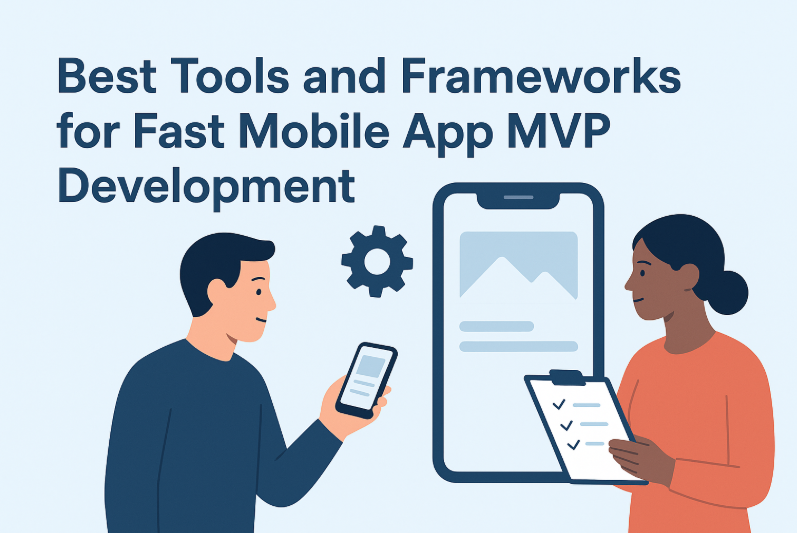MVP Development and UI/UX Design: How to Measure Success Effectively

The best way to test your app idea is to build a Mobile App MVP (Minimum Viable Product) and test it first. With an MVP, you can test the main functionality, collect user feedback, and release quickly without incurring unnecessary expenses.
However, the tools and structures you adopt greatly influence how quickly and efficiently you develop. The right stack supports quicker prototyping, cross-platform Development, scaling, and execution.
This blog will discuss the optimal tools and frameworks for developing a fast Mobile App MVP and tips for creating and launching it successfully.
Why Choosing the Right Tools Matters
Selecting the right tools for your Mobile App MVP impacts:
Speed of Development
Using pre-built components and cross-platform frameworks accelerates the development process.
Cost Efficiency
The right tools reduce unnecessary expenses by avoiding duplicated work and optimising resources.
Scalability
A good tech stack supports future growth, making it easier to add features as your app evolves.
Cross-Platform Reach
Since most apps target Android and iOS, using tools that support multiple platforms saves time and money.
Best Tools for Mobile App MVP Development
Figma – For Prototyping & UI/UX Design
Figma is a design tool that makes wireframing and prototyping easier.
Key Benefits:
- Designer/developer for real-time collaboration.
- Early user testing through fast prototyping.
- Cloud-based for easy sharing
Example:
Before coding, you can make an interactive Figma prototype to test user flows and collect feedback.
Firebase – Backend as a Service (BaaS)
Firebase, an offering of Google, accelerates the backend creation using packaged services.
Key Features:
- Authentication and real-time database.
- Push notifications and cloud storage.
- Intrinsic performance tracking analytics.
Why It’s Ideal for MVPs:
Instead of developing a dedicated backend, it will allow you to deploy your Mobile App MVP quickly.
Postman – API Development & Testing
Postman makes API testing easier, an essential part of mobile apps.
Key Benefits:
- Debugs and tests on the endpoints.
- Roboticize routinized testing.
- Work with your team in harmony.
Jira or Trello – Project Management
The coordination of the team is necessary to develop an MVP quickly.
Why Use Them:
- Track tasks and milestones
- Align testers, designers, and developers.
- Make it more transparent and more productive.
Google Analytics & Mixpanel – User Behaviour Tracking
After your MVP has been deployed, it is necessary to track how users are using it.
Use Cases:
- Retention and engagement.
- Understand user journeys
- Rank features based on data.v
Best Frameworks for Mobile App MVP Development
React Native – Cross-Platform Efficiency
Facebook developed React Native, perfect for creating apps operating across iOS and Android.
Benefits:
- A single codebase saves time on Development.
- A massive library ecosystem to build faster.
- Clean execution and social concern.
Flutter – UI-Focused Development
Flutter Google is ideal for creating beautiful applications.
Benefits:
- Multi-platform single-codebase.
- Ready-to-go widgets to create fast UI.
- Hot-reload capability to accelerate testing.
Kotlin & Swift – Native Development
Native Development is optimal with performance-intensive applications.
- Kotlin on Android: Android is reliable and efficient.
- Swift iOS is Lightweight and fast.
Best: Gaming apps, AR apps, and complex Mobile App MVPs.
Ionic – Hybrid App Development
Ionic is inexpensive for straightforward multiple-platform MVPs.
Benefits:
- Written in JavaScript, HTML, and CSS.
- Easy integration with third-party libraries.
- Best with budget-conscious startups.
Best Practices for Fast Mobile App MVP Development
Concentrate on Core Features – Concentrate on solving your app problem.
Some of the standard systems include:
- Select Cross-Platform Frameworks – Develop in one place, deploy everywhere.
- Take advantage of Third-Party APIs – Do not reimplement standard functionality.
- Test Early and Often – Work out usability problems before launching the product.
- Collect Real User Feedback – Improve with Data and Insights.
Conclusion
Developing an MVP of a Mobile App involves trade-offs between speed, efficiency, and quality. Developing with tools like Figma, Firebase, Postman, and frameworks like React Native, Flutter, and Kotlin can significantly speed up the development work and maintain low costs.
When selecting the appropriate stack and using best practices, you can deploy your Mobile App MVP in minutes, test your idea, and scale easily.
Connect with MVP Center
Ready to take the first step towards unlocking opportunities, realizing goals, and embracing innovation? We're here and eager to connect.




